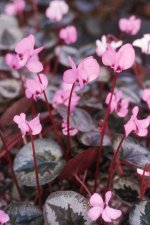 Cyclamen coum
Cyclamen coum
So you'd like some color in the garden late Autumn and
Winter, huh? Well, have I got a plant for
you! Cyclamen coum flowers in my zone 5 garden
from November through February. Whenever the snow melts
back, should we be fortunate enough to have a
blessing of natures best white mulch, I am knocked
out by warm clouds of rose, magenta, pale
pink, dark pink and white floating 6 inches above the
frozen tundra. Even when Cyclamen coum isn't in
flower, the silvery mottled foliage makes a great
groundcover.
After all this plant's hard work giving you such visual
pleasure, I'm sure you'll find it in your heart to
grant these hard working plants the Summer off. After
flowering, the leaves go bye bye and the flower stems
curl up into an adorable spring like coil and lower
themselves to the ground for ripening. Each seed head
can contain up to 25 seeds that spill out a couple of
months later and are carried a short distance by ants that
eat the sweet aril that encircles the seed. The ants
bury the seeds for you and before you know it, you
have a beautiful colony of Cyclamen.
Many home gardeners get a bit queasy when you mention Hardy
Cyclamen. There are usually two reasons for
this. The first is that they've purchased shriveled
up bulbs that were wild collected in Turkey, shipped
to Holland and exported to the US for sale in garden
centers. Well, duh! What do you expect?
The other reason is cultural. They were planted too
deeply or planted in too moist an area. If you only
remember two words when it comes to growing these
plants, it's DRY SHADE!!! And please don't
completely bury the tuber. I know.......everything
you've learned up to this point in your gardening lives,
your gut feelings and intuitions point you toward burying
bulbs, corms and tubers as deeply as possible for
their protection from the freezing blasts of
Winter, but this is not the case with Cyclamen.
Before I go on and on here, let me point you to an
article that I wrote for the Brooklyn Botanic Garden
Journal a long time ago, so that you can get the whole
hardy Cyclamen story - http://www.sunfarm.com/plantlist/cycart.htm
I will add one addendum to that story here. I've cut
back production on Cyclamen hederifolium in favor of
Cyclamen coum for several reasons:
1. Cyclamen coum almost always flowers in its first
year of growth, rarely does Cyclamen
hederifolium
2. Cyclamen coum is hardier than Cyclamen
hederifolium
3. Cyclamen coum has a much wider range of
flower color and more vivid colors than Cyclamen
hederifolium
4. Cyclamen coum sets seeds more prolifically
than Cyclamen hederifolium
Don't misunderstand me here, I LOVE Cyclamen
hederifolium. You can't beat the diversity of the
silvery mottling patterns on the foliage, but
Cyclamen coum has it beat hands down.
A brief note about pronunciation, here in the US of
A, we say SYEKLAMEN in the UK and probably the rest
of the English speaking world, it's SICKLAMEN.
I'm sure that you want to learn more, so I have a few
more resources for you. The Cyclamen Society in the
UK is GREAT, the seed exchange is unparalleled and
the web site is an education in itself - http://www.cyclamen.org/ there is a
link to more information on C. coum at - coum - http://www.cyclamen.org/coum_set.html
Further cultural information can be found at - http://www.sunfarm.com/plantlist/cycons.htm
Taxonomic Hierarchy
Kingdom - Plantae - Plants
Subkingdom - Tracheobionta - Vascular
plants
Superdivision - Spermatophyta - Seed
plants
Division - Magnoliophyta - Flowering
plants
Class - Magnoliopsida -- dicotyledons
Subclass - Dilleniidae
Order - Primulales
Family - Primulaceae
Genus - Cyclamen
Species - coum
Common name - genus -
"Cyclamen", "Sow Bread"
Common name - species - none that I have found
Synonyms - none that I have
found
Native of - Russia, Turkey, Bulgaria,
Lebanon, Israel
USDA Hardiness Zone - zone 5 possibly 4
Light preference - Full shade to dappled sunlight
Soil preference - Average
Moisture preference - DRY DRY DRY
Bloom time - Late Autumn, Early Winter
Bloom color - rose, magenta, pale
pink, dark pink and white
Foliage - Dark green,
glossy, silvery mottling patterned
Spread - forms a colony by seed
Height - 6" - 8" in flower
Landscape uses - Naturalizing in a deep shade or
light sun border, woodland or rock garden - Autumn
and Winter bloom.
Medicinal uses - None that I have found
|


 Cyclamen coum
Cyclamen coum